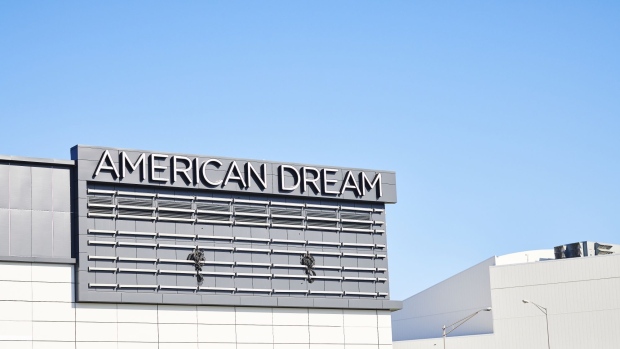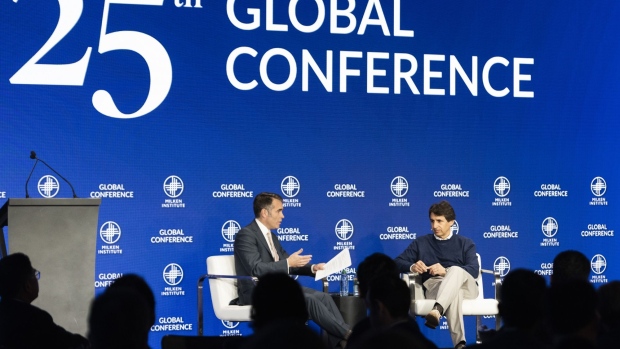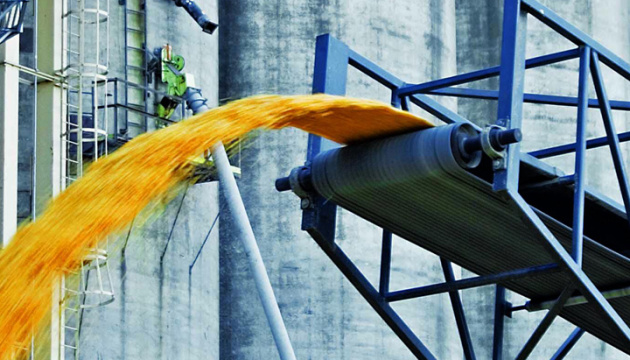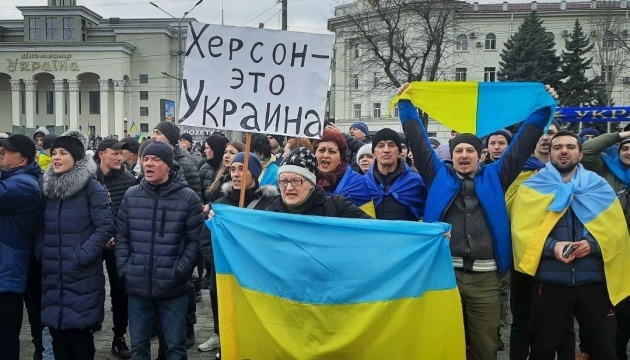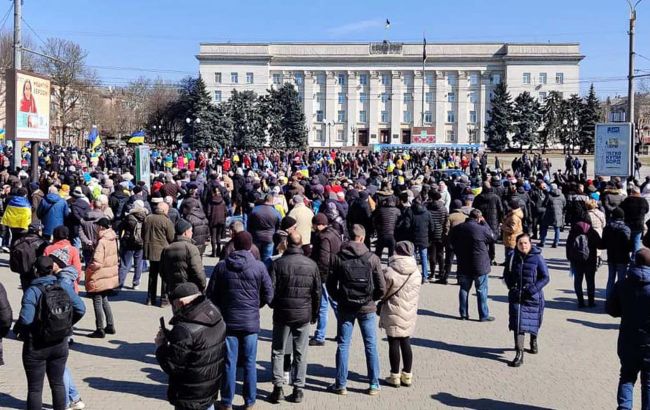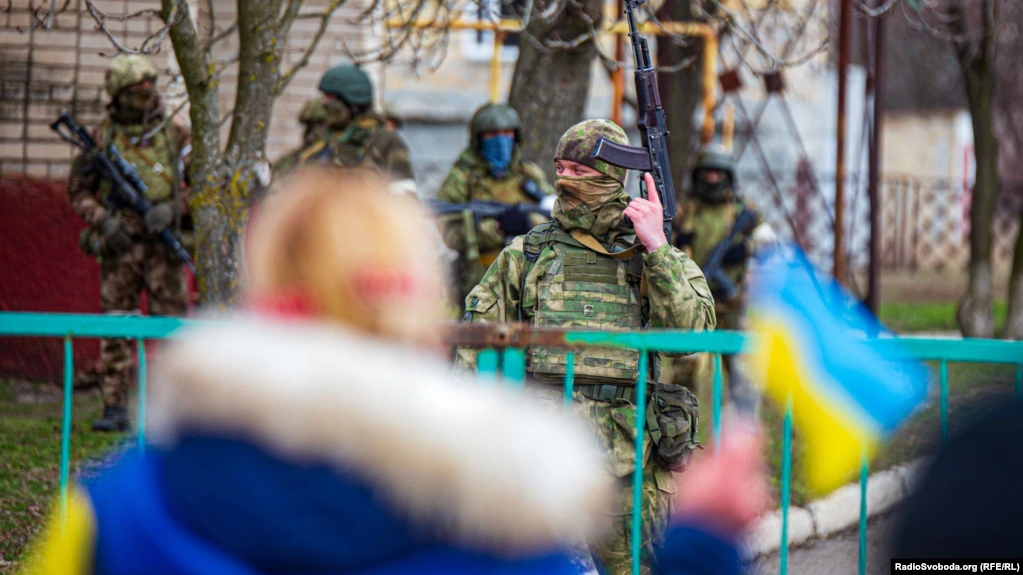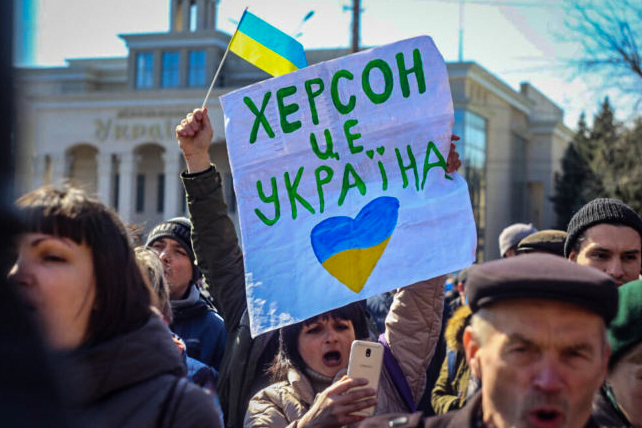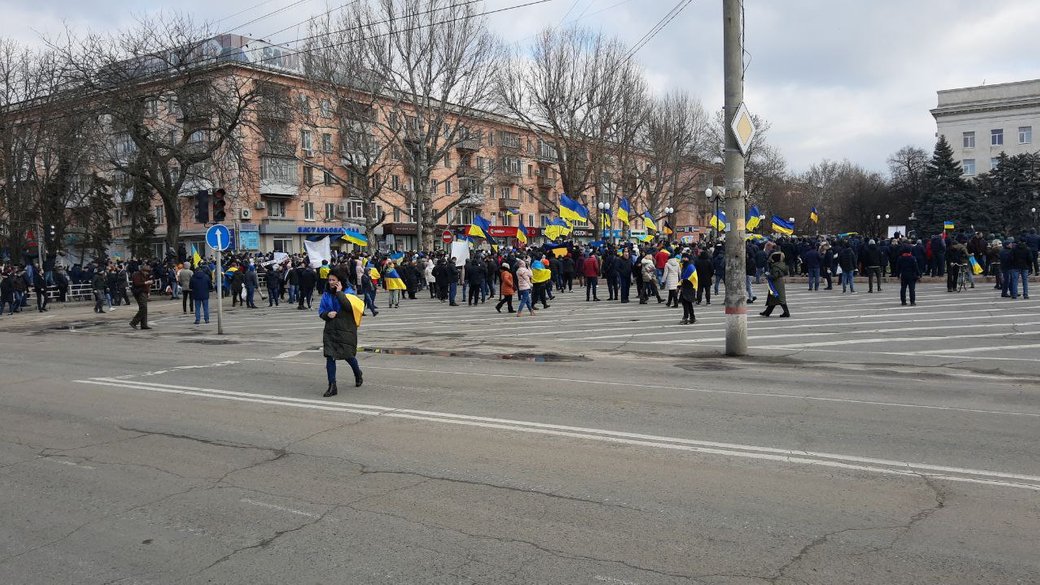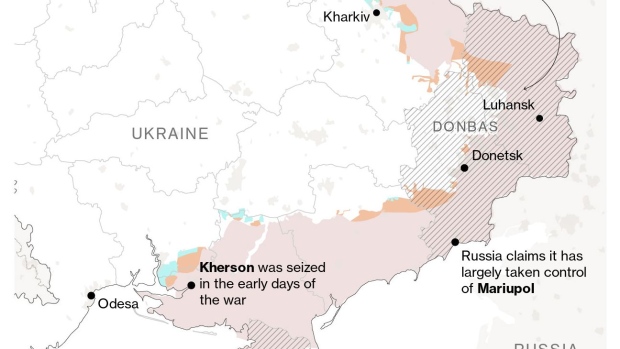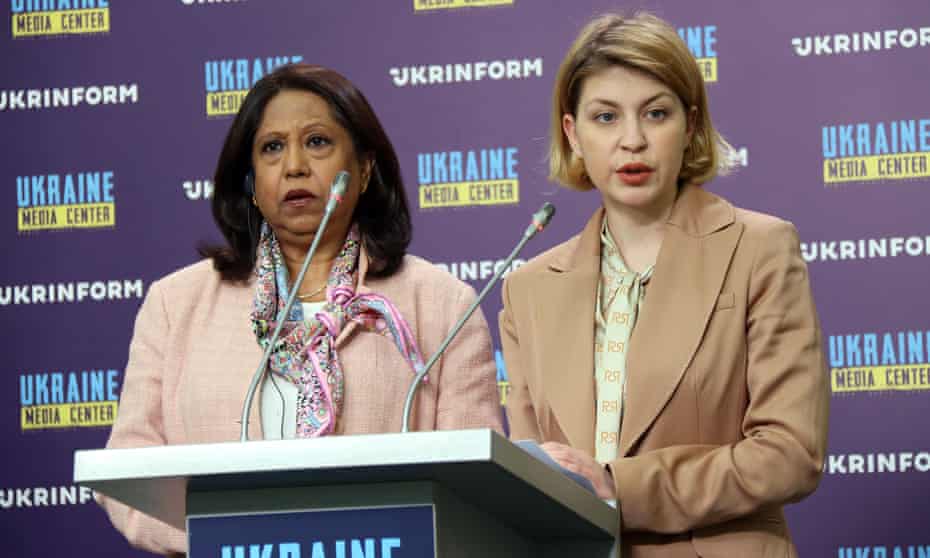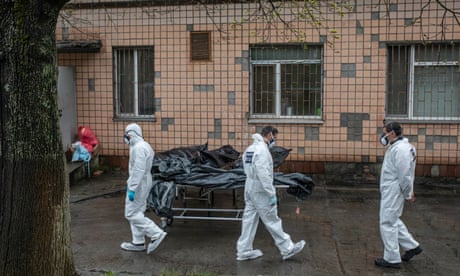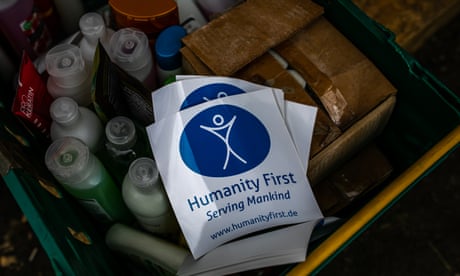(Bloomberg) -- Nearly 10 weeks into the war and with its troops making only marginal gains in Ukraine’s east, Russia is focused on cementing both military and political control over the territory it has taken so far.
The Kremlin is installing occupation governments, ordering locals to use rubles for transactions and, according to three people involved in the efforts, planning hastily organized referendums in some areas to open the way for full annexation. The people spoke on condition of anonymity given the risk of retribution discussing sensitive information. The Kremlin did not respond immediately to a request for comment.
Though far short of President Vladimir Putin’s original aims of ousting President Volodymyr Zelenskiy and installing a pro-Russian regime in most of Ukraine, the latest efforts pose a new obstacle for already-stalled peace talks, in which Kyiv has insisted Russia give up the ground it has taken since invading on Feb. 24. Zelenskiy’s military, backed by infusions of heavy weapons from the U.S. and its allies, plans a push to retake territory.
Kremlin officials, in public and private, are still confident their advance will pick up speed and Russian forces will at least conquer the entire Donetsk and Luhansk regions. Moscow is also seeking to tighten its grip in the southern Kherson and Zaporizhzhia regions, parts of which it has seized. That would leave about a fifth of Ukraine’s territory and most of its coast under Russia’s control -- and create a land link to Crimea, which Moscow annexed in 2014.
In recent days, Russian officials have started talking down public expectations for a major battlefield breakthrough by May 9, the World War II Victory Day holiday and military parade that have become a touchstone of the Kremlin’s campaign to whip up public support for the invasion.
Still, in a sign of its ambitions for Donetsk and Luhansk, the Kremlin has turned responsibility for them over to its domestic politics division from the one that was responsible for neighboring countries, according to people familiar with the situation. Sergei Kiriyenko, the deputy chief of staff responsible for domestic politics, visited the region late last month to lay out his plans with officials there.
Russia’s recognition of the breakaway republics in late February - including swathes of territory it does not control - paved the way for the invasion.
While a U.S. official said Monday that votes on becoming part of Russia could be held in Donetsk and Luhansk as early as mid-May, people familiar with the planning in Moscow said they’re likely to be put off until Russian forces extend control at least to the administrative boundaries of the regions. That could take weeks or months.
Formal annexation of those two territories would make them irrevocably part of Russia, in the Kremlin’s view, permanently fracturing Ukraine as other occupied areas moved to secede.
In the interim, Moscow is replacing local officials loyal to the government in Kyiv, rerouting the occupied regions’ internet connections through Russian servers and censors and mandating the use of the ruble instead of Ukraine’s hryvnia. Kyiv has accused Russia of stealing 400,000 tons of grain from the areas it controls.
“We’ll absorb Ukraine region by region,” Konstantin Malofeev, a wealthy backer of Putin who’s helping fund the war effort including by sponsoring an army of volunteer soldiers, said in an interview.
He conceded that the scale of military aid to Kyiv from the U.S. and its allies “has been far greater than anticipated.” Together with determined Ukrainian resistance, that means a grinding war that “will drag on at a slow pace” for at least months to come, he said.
Sanctioned Tycoon
The U.S. Justice Department unsealed an indictment against Malofeev in April for violating sanctions first imposed on him for his role in Russia’s 2014 annexation of Crimea. At the time, the Treasury Department said he was “one of the main sources of financing for Russians promoting separatism in Crimea.”
While Russia since Feb. 24 has increased its grip on Donetsk and Luhansk from 30% to 75% of the territory of the two Ukrainian regions prior to 2014, according to London-based defense research group Janes, the offensive is currently making relatively little progress.
Russian troops are still fighting to complete the takeover of the port city of Mariupol, where a pocket of Ukrainian resistance is holed up in a giant steel plant after a brutal weeks-long siege that leveled much of the city to ruins.
The Kremlin is preparing for a long, grinding campaign, according to people close to the leadership. With the U.S. and its allies steadily increasing sanctions - reaching the Russian oil and gas exports that had long been thought too vital to touch - Moscow sees little reason to compromise. A Russian general said in late April that Moscow’s goals are now to take over the south as well as the east of Ukraine, which would cut off the country from the sea and its main export routes. No senior official has publicly endorsed that ambition, however.
Privately, some Russian officials concede the situation on the ground in the occupied territories is chaotic and they haven’t yet been able to assert control and impose order.
Kherson, where a military-civilian administration headed by a former mayor of the region’s main city was appointed by Russia on April 26, will follow Luhansk and Donetsk in joining Russia, Malofeev said. At a minimum, the Kremlin should incorporate the entire southeast of Ukraine, a chunk of territory historically known as Novorossiya (New Russia) that Czarist Russia captured from the declining Ottoman Empire in the 18th century, he said.
Ambitious Goals
Without its ports and main export routes for wheat, coal and metals, “Ukraine will lose any economic independence,” Malofeev said.
He’s boosting propaganda and dispensing largess. His pro-Kremlin channel, Tsargrad, has correspondents fanning out across newly-occupied areas including Mariupol and Kherson, and he’s donated a billion rubles ($15 million) to buy generators, medicines, minivans and other supplies. The Russian government is also preparing to fund reconstruction, he said.
Alexander Borodai, a Russian legislator who briefly served as head of the Donetsk People’s Republic and leads the “volunteer” force set up by Malofeev fighting alongside Russian troops, said the Ukrainian state should be “dismantled and disappear from the face of the Earth.”
At least for now, it’s not clear that Russia is capable of exerting full control of Donetsk and Luhansk. In the south, Odesa, the biggest Ukrainian port, remains firmly in Ukrainian hands. Kharkiv, the major north-eastern city, is also holding out.
Zelenskiy has urged Ukrainians in occupied territories not to cooperate with Russian authorities.
Even in Kherson, which fell with little fighting in March, Russian forces still don’t have total authority. Russia has set up filtration camps targeting men of military age or who served in the country’s security forces, Ukrainian officials said.
The city has seen protests with participants holding up Ukrainian flags. The region’s Kyiv-loyal governor, Hennadiy Laguta, in mid-April visited an area freed by Ukraine’s army and oversaw the restoration of electricity, police patrols and health services. Schoolchildren in the Kherson region are continuing to study in Ukrainian schools online.
©2022 Bloomberg L.P.
Why Mariupol and the Donbas Region Matter to Putin

Why Mariupol and the Donbas Region Matter to Putin
(Bloomberg) -- Russia’s recognition of Ukraine’s separatist Donetsk and Luhansk People’s Republics in the east of the country was the precursor to President Vladimir Putin’s Feb. 24 invasion of Ukraine and, increasingly, its primary territorial goal and justification. That has dramatically raised the stakes in a region stretching north from the war-ravaged port city of Mariupol, scene of some of the fiercest fighting and that from 2014 was already riven by a Russia-backed insurgency. Western officials have responded by hitting Moscow with some of the heaviest sanctions in modern history, putting eastern Ukraine at the heart of one of Europe’s biggest security crises since the Cold War.
1. Where are Donetsk and Luhansk?
Long the home of Cossacks, the region came under control of the Russian Empire in the mid-18th century, soon after the discovery of the coal basin that would provide its nickname – the Donbas. The coal attracted industry and Russian settlers from the mid-19th century, turning Donetsk and Luhansk into Ukraine’s industrial heartland. With its substantial Russian-speaking population, the Donbas became a bedrock of support for Viktor Yanukovych, the Donetsk-born former president toppled in 2014 by street protests over his decision -- under pressure from Moscow -- to renege on signing a trade association pact with the European Union. The siege of Mariupol, the Donetsk region’s second-largest city on the coast between Russia and Crimea, became a major focus of the war in Ukraine, with Russian forces laying waste to its buildings and forcing much of its population of almost 500,000 to flee.
2. How did the trouble start?
Following Yanukovych’s removal in 2014, which Russia saw as a Western-backed coup, Putin sent unbadged troops to annex Crimea, a peninsula jutting into the Black Sea from the Ukrainian mainland, without a shot being fired. Opponents of the new pro-Western government in Kyiv tried to emulate that success by taking control in cities across the eastern and southern regions of Ukraine. But this time there was resistance. Clashes broke out and an armed conflict developed in the Donbas. Russia denies allegations that it fomented the protests. It’s clear many in the region wanted stronger ties with Russia, though not that they wanted to join it or fight. One of the first commanders of the separatist forces, Igor Girkin, otherwise known as Strelkov, was a Russian citizen who had been involved in Moscow’s operation to secure Crimea.
3. Why is Russia focused on this area?
Putin has made clear since at least 2007 that he does not accept Europe’s post-Cold War, U.S.-dominated security architecture. He since tried to carve out a sphere of influence for Moscow in the former Soviet space, pushing back against efforts by Russia’s neighbors to join or associate with the North Atlantic Treaty Organization or, later, the European Union. He tried instead to build Russian-led equivalents -- the Collective Security Treaty Organization and Eurasian Economic Union -- but without Ukraine, a fellow Slav nation of at least 41 million, they could amount to little. Russia’s focus now appears to be to take those parts of Donetsk and Luhansk not already under its control and secure a land corridor to Crimea.
4. How valuable are the provinces?
The separatist territories are partly of value to Russia for the disruption they cause Ukraine, cutting key transport links and supply chains. The territories produce coal and are home to some substantial factories, but the economy has been largely destroyed, with the conflict leaving about 14,000 people dead just in the period between 2014 and the start of Putin’s more recent invasion. Many more have died since, in particular during the siege of Mariupol, which was important economically because of its steel industry and port facilities, making it an export hub for steel, coal and corn. Large numbers fled the fighting and lack of rule of law in the territories, heading either for other parts of Ukraine or Russia. One 2020 study already estimated the cost of reconstruction at $21.7 billion, even before the widespread destruction caused by the 2022 invasion, a bill that now falls to the Kremlin.
5. Why does the West care?
Putin is demanding a wholesale restructuring of Europe’s security order and has now altered the borders that emerged from the collapse of the former Soviet Union four times -- twice in Georgia and, after Crimea and the Donbas, twice in Ukraine. He has also forced a much closer union on the embattled leader of Belarus, Alexander Lukashenko, with the result that a major thrust of the 2022 invasion of Ukraine was conducted from his territory. That’s worrying for the neighboring Baltic states and Poland -- all NATO members -- which have sanctioned Belarus and participated in the response in the region.
Marc Champion
April 21, 2022
An International Crisis Group study on “Conflict in Ukraine’s Donbas.”
A report by the Vienna Institute for International Economic Studies on the economic challenges and costs in the Donbas.
A Washington Post article on the siege of Mariupol.
